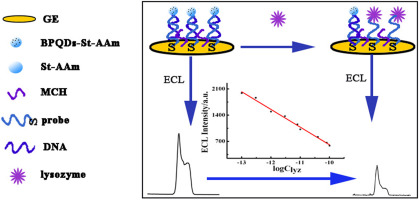Talanta ( IF 5.6 ) Pub Date : 2019-03-02 , DOI: 10.1016/j.talanta.2019.02.099 Hui Liu , Yu Zhang , YongPing Dong , XiangFeng Chu

|
Black phosphorus quantum dots (BPQDs) can react with Ru(bpy)32+ to generate strong anodic electrogenerated chemiluminescence (ECL). However, the instability and the lack of functional groups on BPQDs limit its further application in the fabrication of ECL biosensor. In the present work, uniform BPQDs-styrene-acrylamide (St-AAm) nanospheres (BSAN) are synthesized by encapsulating BPQDs into St-AAm copolymer nanospheres. Sufficient amount of BPQDs can be embedded into nanospheres, and react with Ru(bpy)32+ to generate strong anodic ECL which is comparable to that of pure BPQDs. Amino group of polymer endows BPQDs the ability to connect with DNA, and can be used to fabricate ECL aptasensor for the sensitive detection of lysozyme. The proposed aptasensor shows high sensitivity, good selectivity and stability for the detection of lysozyme in the range of 0.1–100 pg mL−1 with a detection limit of 0.029 pg mL−1 (3σ). The proposed method reveals the promising ECL sensing application of BP nanomaterials in the detection of various proteins.
中文翻译:

基于共聚物纳米球包裹的黑磷量子点的溶菌酶电化学发光适体传感器
黑磷量子点(BPQD)可以与Ru(bpy)3 2+反应生成强阳极电致化学发光(ECL)。但是,BPQD的不稳定性和官能团的缺乏限制了其在ECL生物传感器的制造中的进一步应用。在目前的工作中,通过将BPQDs封装到St-AAm共聚物纳米球中来合成均匀的BPQDs-苯乙烯-丙烯酰胺(St-AAm)纳米球(BSAN)。足够数量的BPQD可以嵌入纳米球中,并与Ru(bpy)3 2+发生反应产生与纯BPQD相当的强阳极ECL。聚合物的氨基赋予BPQD与DNA连接的能力,可用于制造ECL适体传感器,用于灵敏地检测溶菌酶。拟议的适体传感器在0.1–100 pg mL -1的范围内对溶菌酶的检测显示出高灵敏度,良好的选择性和稳定性,检测极限为0.029 pg mL -1(3σ)。所提出的方法揭示了有前景的BP纳米材料在ECL传感中检测各种蛋白质的应用。































 京公网安备 11010802027423号
京公网安备 11010802027423号